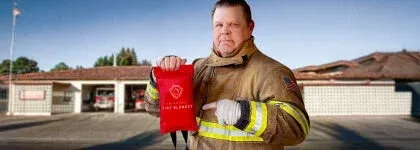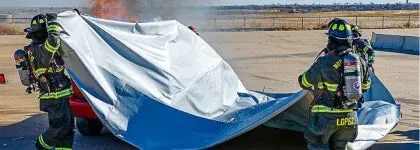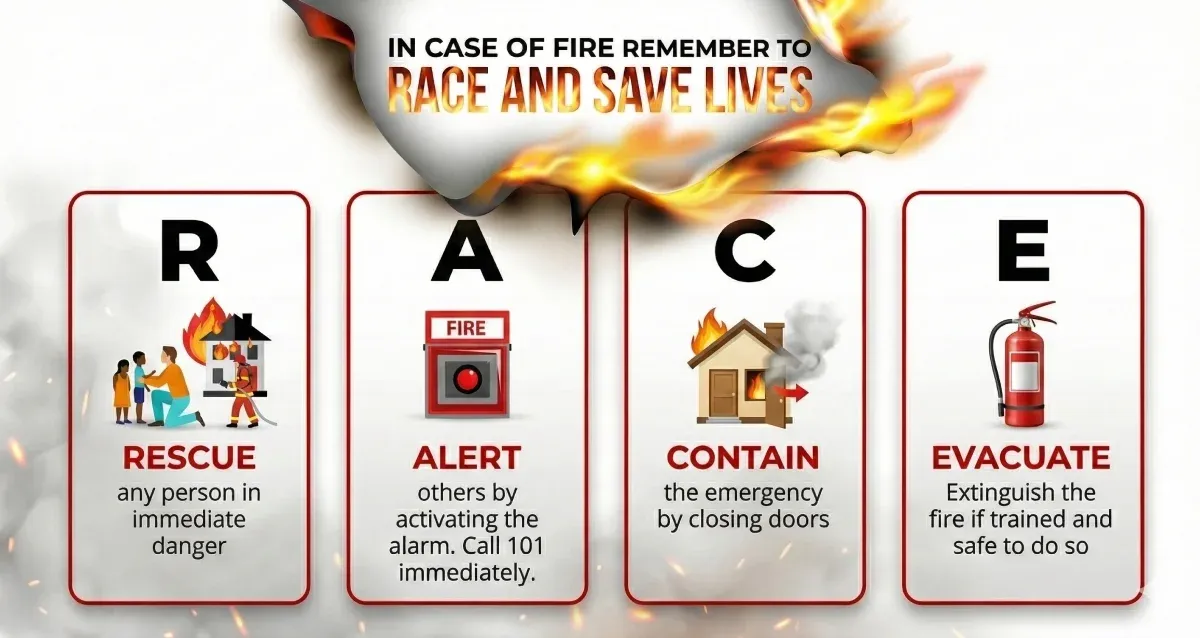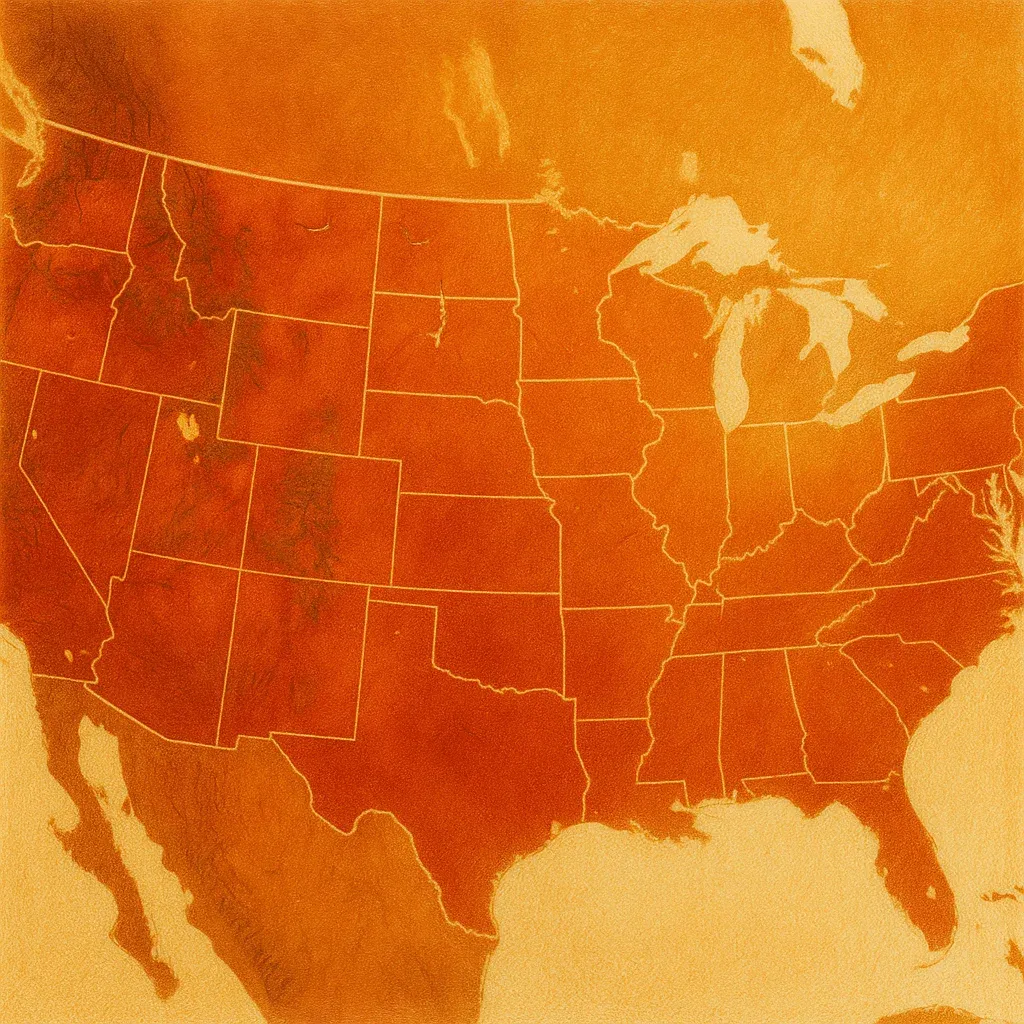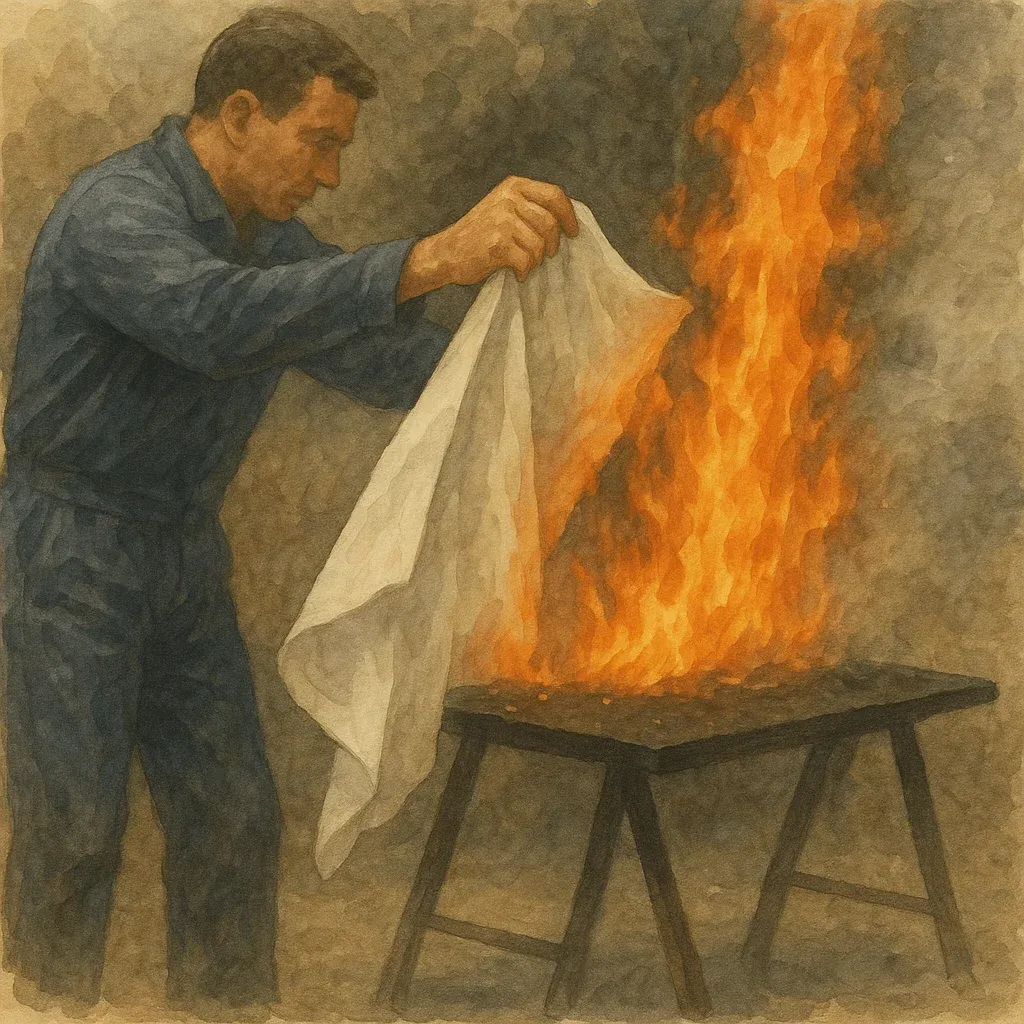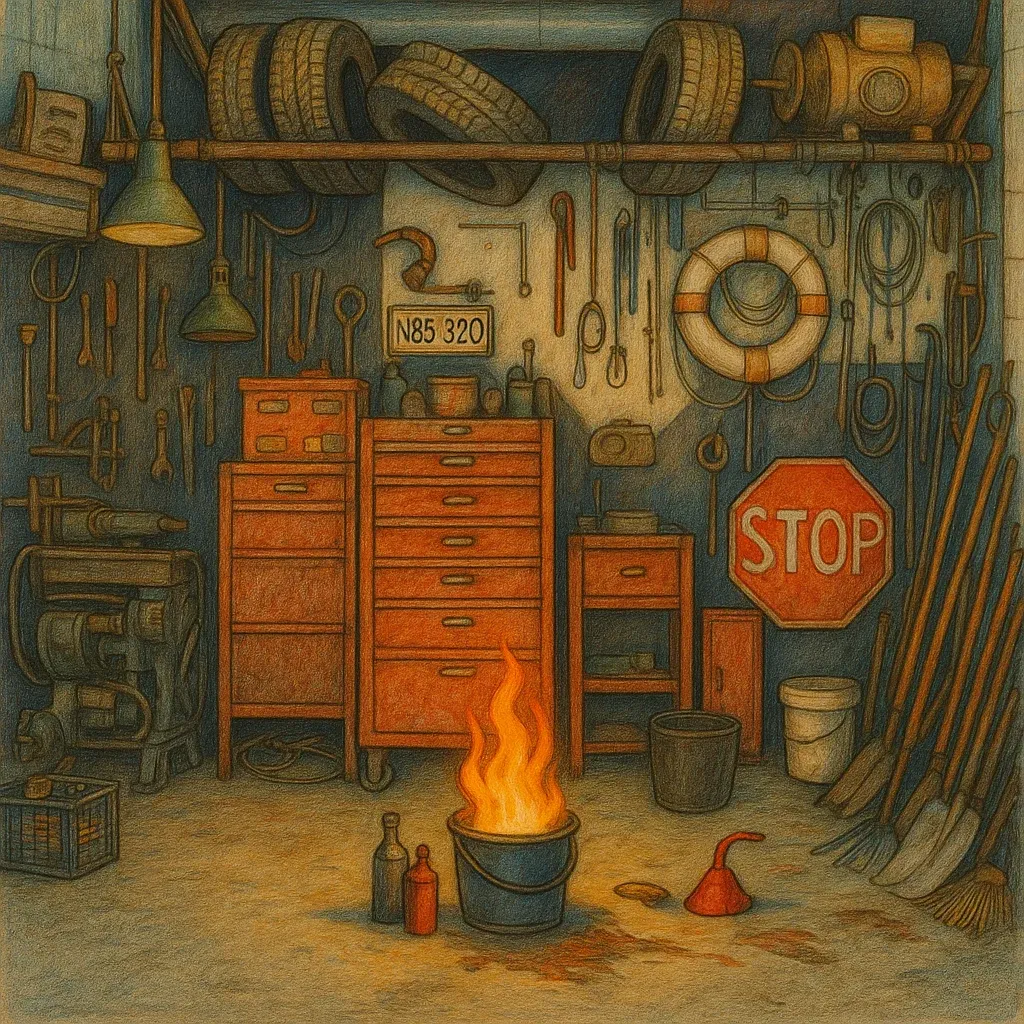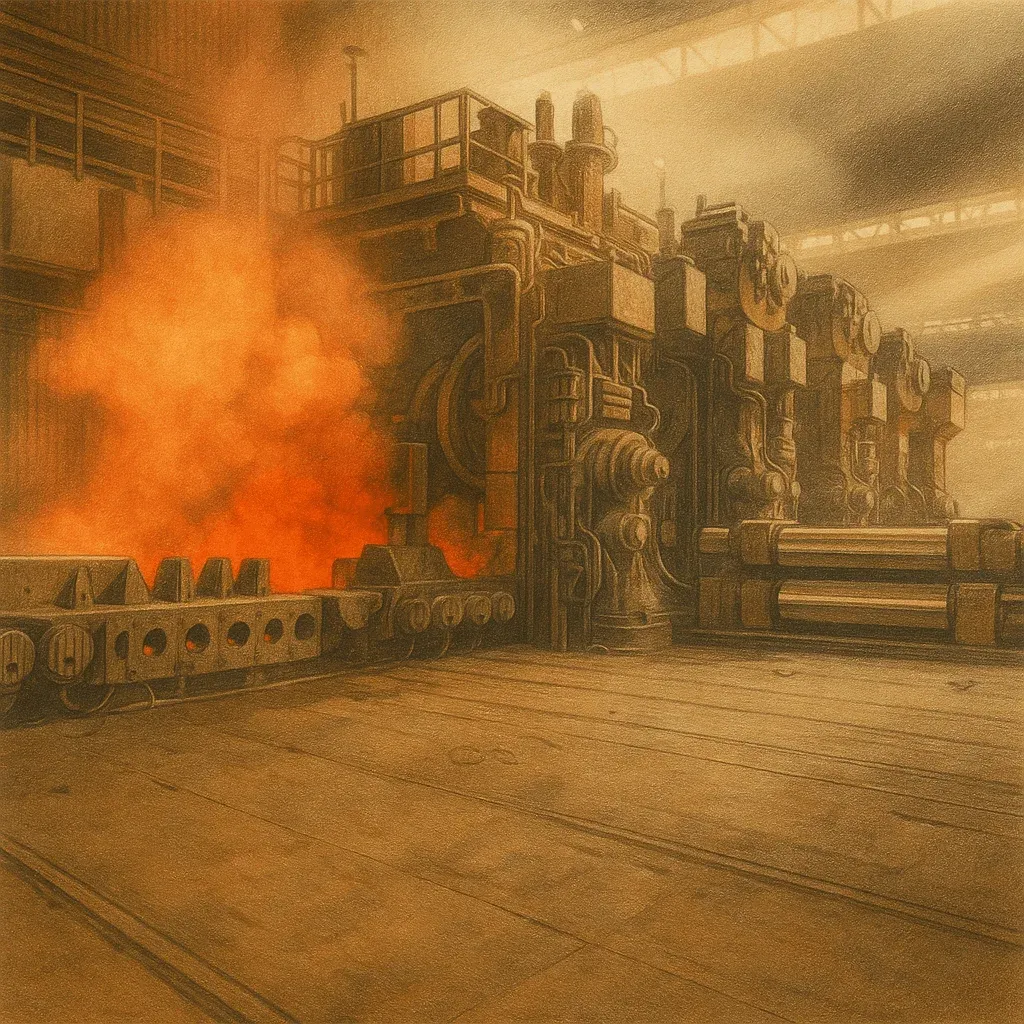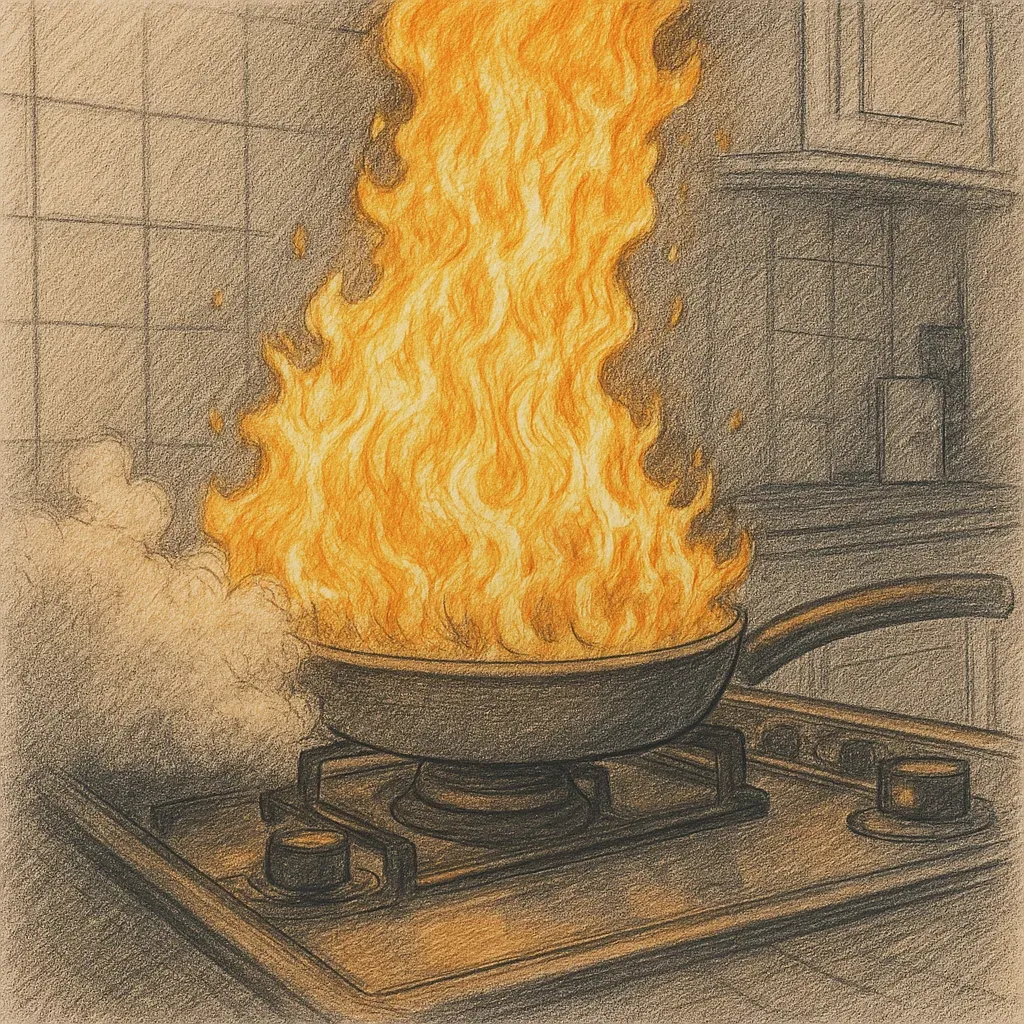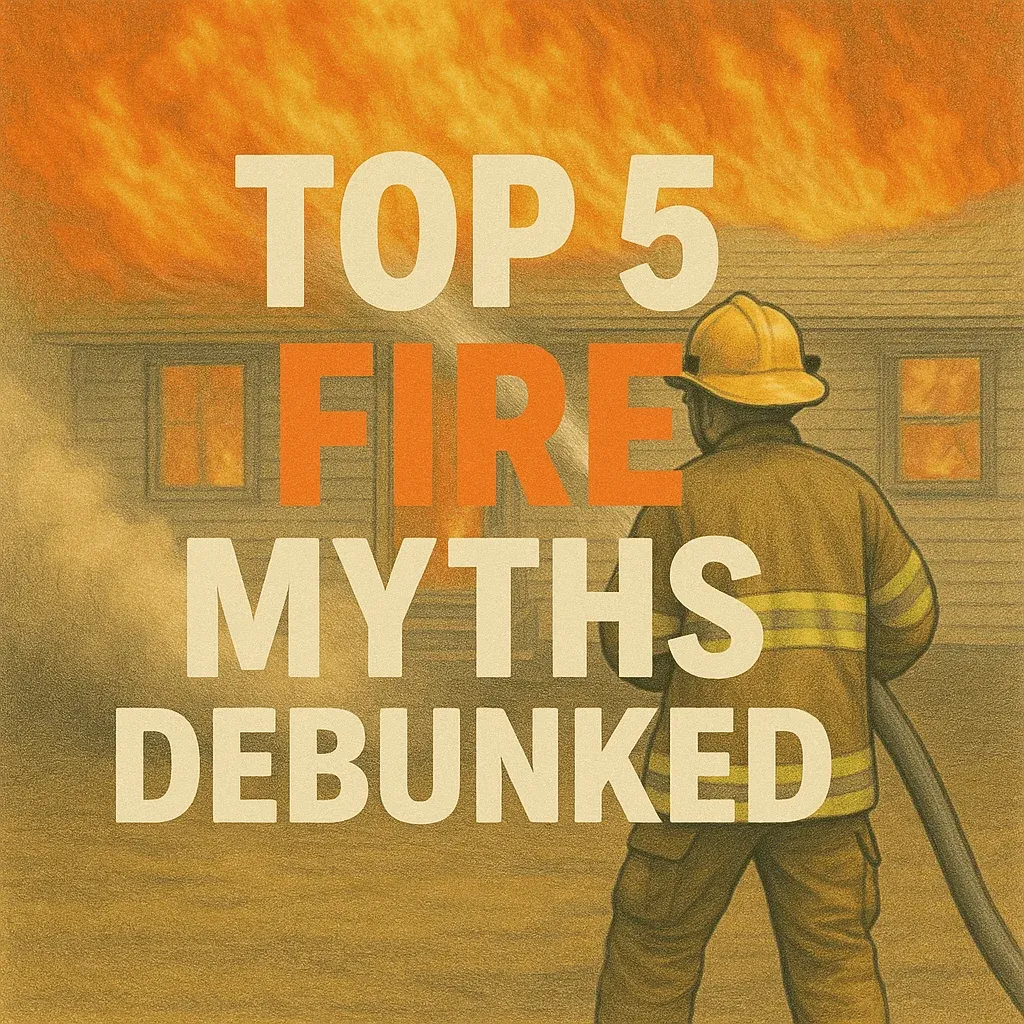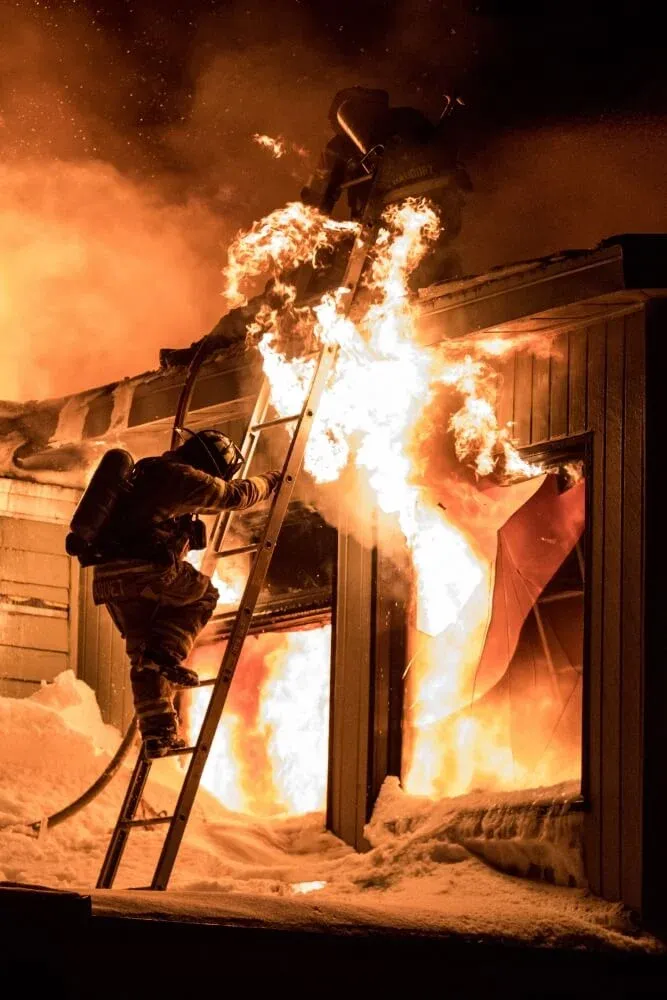You're sanding down that bookshelf project while a rag with linseed oil sits forgotten on your workbench. In less than a minute, that oily rag can go from harmless to flaming disaster. I've seen it dozens of times during my firefighting career. Workshop fires start small, but they rarely stay that way.
Here's the reality: when a fire ignites in your garage or workshop, you've got about three minutes to make critical decisions before that manageable flame becomes something only professionals should handle. After responding to hundreds of structure fires, I can tell you that what you do in those first moments often determines whether you'll be sweeping up minor damage or rebuilding from scratch. For a complete overview of fire blanket types and how they work, see our detailed guide.
Understanding Workshop & Garage Fire Behavior
Workshops and garages pack a perfect fire storm that most homeowners don't fully grasp. Unlike your living room, these spaces combine fuel, ignition sources, and often poor ventilation in ways that create rapid fire growth.
Common ignition sources in workshops include:
- Electrical tools with frayed cords or internal shorts
- Battery charging stations (especially lithium-ion)
- Spontaneous combustion in oil-soaked rags
- Sparks from grinding, welding, or cutting operations
- Chemical reactions between improperly stored products
- Overheated motors in dust-filled environments
What makes these fires particularly dangerous is how they spread. Workshop fires often burn undetected longer than house fires. Most garages lack proper smoke detection, and the materials involved, wood dust, solvents, plastics, produce thick, toxic smoke that can incapacitate you before you've even registered danger.
A workshop fire can jump from first spark to fully involved in under five minutes. I've investigated fires where homeowners stepped away "just for a coffee" and returned to find their entire garage engulfed.
The typical smoke detector setup often fails in workshops for several reasons:
- Detectors get clogged with dust and fail
- Many garages lack detectors entirely
- High ceilings allow smoke to stratify away from detectors
- Temperature extremes in uninsulated spaces can affect detector performance
What's worse, most garages connect directly to homes, creating a fast pathway for fire spread into living spaces. A fire that starts in your workshop can be in your bedroom surprisingly quickly, especially at night when detection is delayed.
Your Workshop Fire Attack Plan
When you spot a fire in your workshop or garage, your first instinct might be to grab the nearest extinguisher and charge in. Hold that thought. In my years of fire service, I've seen too many people injured by skipping a critical 3-second assessment.
First, size up the situation:
- How big is the fire? Anything larger than a trash can is potentially beyond a homeowner's capability.
- What's burning? Different materials require different approaches.
- What tools do you have immediately available? The key word is "immediately"; if your extinguisher is buried under holiday decorations, it might as well not exist.
Next, make the fight-or-flight decision. You should only attempt to fight a fire if:
- The fire is small and contained (smaller than a trash can)
- You have a clear escape path
- You have appropriate extinguishing tools at hand
- The room isn't filling with smoke
- You can hold your breath while fighting the fire (if you need to breathe, the smoke is too toxic)
If you decide to fight the fire, position yourself correctly:
- Stay low where visibility is better and air is cleaner
- Keep your back to an exit
- Start farther away than you think necessary and move closer only if safe
- Protect yourself first; clothes can be ignited by radiant heat even without direct flame contact
In my experience, most civilian fire injuries happen not from the initial fire but during amateur firefighting attempts. Don't be a statistic; be strategic.
The Workshop Fire Fighter's Toolkit
Every workshop should have specific fire safety equipment, properly maintained and strategically placed. Based on hundreds of post-fire investigations, here's what actually works:
Class-specific fire extinguishers
Workshops need at minimum a 3A:40B:C rated extinguisher, which handles wood/paper fires, liquid fires, and electrical fires. For metalworking shops, add a Class D extinguisher for metal fires.
The extinguisher rating system tells you what fires it can handle and how effective it is. The letter indicates fire type (A for ordinary combustibles, B for flammable liquids, C for electrical), while the number shows relative effectiveness. Higher numbers mean more firefighting power.
Mount extinguishers near exits but not right next to likely fire sources. You don't want to reach through flames to grab your extinguisher.
Fire blankets
These are among the most versatile fire tools in a workshop setting. Fire blankets can smother flame on small fires, wrap burning items, shield you during escape, and even provide emergency burn treatment. Look for blankets certified to EN 1869:2019 standards or UL-listed products.
A proper workshop fire blanket should be:
- At least 39"x39" for versatility
- Mounted visibly near exit paths
- Free from obstructions
- Not stored near potential fire sources
Unlike extinguishers, fire blankets don't create additional mess, don't expire, and require virtually no maintenance. They're particularly effective for smothering fires on flat surfaces like workbenches or for wrapping burning objects.
Fire resistant cabinets
These specialized storage units keep flammable liquids contained and can prevent a small fire from accessing your most dangerous materials.
A proper flammables cabinet is worth every penny if you store paints, thinners, or solvents. They're designed to keep contents cool for at least 10 minutes during a fire, giving you precious time to evacuate or extinguish the fire before it becomes catastrophic.
Emergency shut-offs
Every workshop should have easily accessible main power disconnects and, if applicable, fuel shut-off valves that can be operated even in low visibility.
Label them clearly and keep the path to them clear. I recommend painting the area around shut-offs in bright colors or adding photoluminescent (glow in the dark) tape that will be visible through light smoke.
The toolkit approach requires thinking through scenarios before they happen. In my department, we call this "pre-planning," and it's what separates successful fire operations from disasters. Your workshop deserves the same level of planning we give to commercial buildings.
Tackling Specific Workshop Fire Scenarios
Let's walk through the most common workshop fire scenarios I've responded to and how to handle each efficiently:
Electrical Tool/Equipment Fires
When a power tool or piece of equipment catches fire, you're dealing with a combination of electrical, plastic, and potentially flammable liquid (oil) fire.
Efficient approach:
- Kill the power if possible without approaching the fire
- Use a Class C fire extinguisher, aiming at the base of the fire
- If extinguisher isn't immediately available, a fire blanket can smother small electrical fires
- Never use water on electrical fires unless power is completely disconnected
Real-world example: A woodworker's table saw motor overheated and ignited sawdust underneath. He used a fire blanket to smother the initial flames, then unplugged the saw and finished the job with an extinguisher. Total damage: under $200. The alternative could have been losing a $30,000 workshop.
Flammable Liquid Fires
Solvent, finish, and fuel fires spread incredibly quickly and can't be treated like ordinary fires.
Efficient approach:
- Resist the urge to move the burning container
- If the fire is contained in a container, use a tight-fitting metal lid if available
- For spill fires, use a dry chemical extinguisher (Class B) in a sweeping motion
- Fire blankets can be effective on small liquid fires if dropped carefully onto the burning liquid
- Never use water; it will spread the burning liquid
Real-world example: A homeowner knocked over a can of mineral spirits that ignited from a nearby water heater pilot light. He successfully smothered it with a fire blanket, preventing potential disaster. The blanket was sacrificed, but it saved thousands in potential damage.
Combustible Material Fires
Wood, paper, and fabric fires are common in workshops and relatively straightforward to address if caught early.
Efficient approach:
- Remove unburned materials if safely possible
- Use water for deep-seated materials like wood piles
- Use an extinguisher for surface fires on workbenches
- Fire blankets work exceptionally well for smothering flat surface fires
Real-world example: A stack of oily rags spontaneously combusted in a furniture maker's shop. The fire was discovered quickly and smothered with a nearby fire blanket, preventing it from reaching finishing supplies that would have caused a major fire.
Battery Fires
With the proliferation of lithium-ion batteries in cordless tools, these fires are becoming increasingly common and are particularly dangerous.
Efficient approach:
- Never use water on a lithium battery fire unless you have large quantities
- Don't try to move a burning battery
- Class D extinguishers can work for some battery chemistries
- A fire blanket can contain small battery fires and prevent spread to nearby materials
Real-world example: A contractor's drill battery overheated while charging. He noticed smoke, unplugged it, and covered it with a fire blanket. The battery still vented and burned, but the fire blanket contained the fire until it burned out.
Metal Fires
For workshops that involve grinding, cutting, or machining metals like magnesium, aluminum, or titanium, metal fires present unique challenges.
Efficient approach:
- Never use water or regular extinguishers; they can cause violent reactions
- Use only Class D dry powder extinguishers
- In an emergency, dry sand can help contain small metal fires
- Fire blankets generally aren't effective on active metal fires but can help contain spread
Real-world example: A home machinist had an aluminum shaving fire start from grinding. He used a Class D extinguisher to control it before it could spread to nearby flammable materials.
Understanding which fire-fighting approach matches which scenario isn't just smart; it's potentially lifesaving. The National Fire Protection Association reports that over 4,000 workshop and garage fires occur annually in homes, with improper response being a major factor in fire spread.
Fire Blanket Techniques for Workshop Fires
Fire blankets deserve special attention in workshop settings because they're versatile, simple to use, and don't create the mess that extinguishers do. Here's how to use them effectively for different workshop scenarios:
The Wrap and Smother Technique for Tool Fires
When a power tool catches fire:
- Disconnect power if possible
- Pull the fire blanket from its container using the tabs
- Shield your hands with the blanket corners
- Wrap the blanket completely around the burning tool
- Set the wrapped tool on a non-combustible surface
- Keep it wrapped for at least 30 minutes; hidden hot spots can reignite
This technique works because it both smothers the flames by cutting off oxygen and contains any melting plastics or burning materials. The key is complete coverage with no air gaps.
The Drop Technique for Bench-Top Fires
For fires on flat surfaces:
- Pull blanket from container using the tabs
- Hold the blanket in front of you as a shield
- Approach the fire from the upwind side if possible
- Lay the blanket gently over the fire, starting from the edge closest to you and moving forward
- Keep the blanket in place for at least 30 minutes
The drop technique requires practice to execute smoothly. Try it with your fire blanket (without an actual fire) so your muscle memory is ready when you need it. The gentle laying motion is critical; throwing or dropping the blanket can create air currents that feed the fire momentarily.
Using Fire Blankets for Personal Protection
If you need to escape through or near flames:
- Wrap the blanket around your body, covering all exposed skin
- Keep the blanket between you and the fire
- Move quickly but cautiously
- Remember the blanket provides temporary protection, not immunity
This technique saved one of my crew members during a flashover situation. The protection is brief, but those few seconds can be the difference between a safe evacuation and serious burns.
Fire Blanket Placement Strategy
Strategic placement can make all the difference:
- Mount primary fire blanket near the main exit
- Consider a second blanket near high-risk areas (solvent storage, battery charging stations)
- Keep blankets at grabbing height (about 5 feet from the floor)
- Ensure the mounting location remains visible and unobstructed
- Check regularly that the blanket container opens easily
Fire blankets in workshops should be larger than kitchen models when possible. While standard kitchen fire blankets (typically 3'x3') can work, workshops benefit from larger 4'x6' or even 6'x8' blankets that can cover larger areas or wrap bulky items. Check our fire blanket buying guide for size recommendations by application.
According to FEMA's fire statistics, having the right fire suppression tools in accessible locations can reduce property damage by up to 60% in workshop fires.
Quick Reference Card
Print this and post near your fire blanket:
- PULL tabs down hard
- WRAP hands in blanket edges
- APPROACH low and slow
- DEPLOY near to far
- SEAL all edges
- WAIT 30 minutes minimum
- CALL 911 always
After the Fire: Preventing Reignition
Many workshop fires reignite hours after people think they're extinguished. As a firefighter, I've responded to plenty of "rekindles" that could have been prevented.
Cooling and Monitoring
Even after flames are out, materials can retain enough heat to reignite:
- Wait at least 30 minutes before unwrapping items covered with fire blankets
- Use a thermal imaging camera if available (many smartphones now have thermal capabilities)
- Check hidden areas where heat can be trapped
- Apply water to thoroughly cool materials like wood that can harbor deep-seated hot spots
The cooling period is critical. Materials like upholstery, wood, and especially oily rags can maintain internal heat long after visible flames are gone. This heat can slowly build back up to ignition temperature if not properly addressed.
Ventilation Strategies
Proper ventilation after a fire is crucial:
- Open doors and windows to remove smoke
- Use fans to create cross-ventilation
- Don't create strong air currents until you're sure the fire is completely out
- Remember that introducing fresh oxygen to a not-fully-extinguished fire can cause a flare-up
I've seen homeowners accidentally "resurrect" seemingly extinguished fires by ventilating too early. Wait until you're absolutely certain the fire is out before introducing significant airflow.
Fire Watch Procedures
After any workshop fire, even a small one:
- Check the area every 15 minutes for the first hour
- Then every 30 minutes for the next two hours
- Make a final check before leaving the space unattended
- Have extinguishing tools ready during this period
Fire watch might seem excessive for a small fire, but it's standard procedure for fire departments for good reason. Hidden embers can lurk for hours before finding enough fuel and oxygen to reignite.
Professional Assessment Needs
Know when to call in professionals:
- Any fire that reached structural components (walls, ceiling)
- Fires involving electrical systems
- Any fire where you're not 100% confident in the extinguishment
- Fires involving specialized equipment
Always call 911 for any fire larger than what you'd find in a wastebasket, even if you think you've put it out. Fire departments would rather check a successfully extinguished fire than return for a major rekindle.
The U.S. Fire Administration guidelines recommend professional inspection after any fire that required an extinguisher to put out, even if it seems completely controlled.
Garage and Workshop Fire Prevention Strategies
While knowing how to fight fires is essential, preventing them altogether is always better. Let me share some prevention strategies that have helped my firefighting clients protect their workshops:
Smart Storage Solutions
How you store materials can significantly impact fire risk:
- Keep oily rags in metal containers with self-closing lids
- Store flammable liquids in approved safety cabinets
- Keep combustibles at least 3 feet from heat sources
- Don't stack materials to the ceiling; maintain 18 inches of clearance
- Create designated storage areas for flammables, away from work zones
I worked with one woodworker who installed simple metal garbage cans with tight-fitting lids specifically for oily rag disposal. This $30 investment potentially saved his entire shop from a spontaneous combustion incident.
Electrical System Maintenance
Electrical issues cause approximately 30% of workshop fires:
- Inspect tool cords regularly for damage
- Don't overload circuits; know your amperage limits
- Use surge protectors for sensitive equipment
- Consider installing AFCI (Arc Fault Circuit Interrupter) breakers
- Keep dust away from motors and electrical components
- Install proper workshop lighting to reduce the need for temporary setups
One simple upgrade that pays dividends is replacing standard outlets near workbenches with ones that include USB ports for charging cordless tools. This eliminates the temptation to use cheap chargers that can overheat.
Dust Management Systems
Wood dust isn't just a nuisance; it's a significant fire hazard:
- Install and maintain dust collection systems
- Empty dust collectors regularly
- Keep floor areas swept
- Consider a ceiling-mounted air filtration system
- Clean dust from rafters and horizontal surfaces periodically
I visited one workshop after a small fire and found that dust had accumulated on overhead lighting fixtures. The heat from the lights had eventually ignited the dust, which then dropped flaming particles onto the workbench below.
Enhanced Detection Systems
Standard home smoke detectors often aren't ideal for workshops:
- Install heat detectors rather than smoke detectors in dusty areas
- Consider connecting workshop detectors to whole-house systems
- Look into smart detection systems that can alert your phone
- Install carbon monoxide detectors if you use fuel-burning equipment
- Test all detection systems monthly
Heat detectors are less prone to false alarms in workshop environments but still provide crucial early warning. For about $30 each, they're one of the best safety investments you can make.
According to a study by the National Fire Protection Association, working smoke alarms cut the risk of dying in a home fire by 55%.
Workshop Layout Considerations
How you arrange your space impacts both fire prevention and your ability to respond:
- Maintain clear paths to exits
- Position fire blankets and extinguishers near exits
- Keep heat-producing equipment away from combustibles
- Create separate zones for different activities (finishing, cutting, etc.)
- Ensure adequate ventilation for all operations
One clever approach I've seen is using colored tape on the floor to mark safety zones, similar to what's done in industrial settings. Red zones indicate high-risk areas, yellow for caution areas, and green for safe pathways and exit routes.
Workshop Fire Drills: Practice Makes Perfect
You might feel silly running a fire drill in your own workshop, but it can make all the difference when seconds count:
Basic Workshop Fire Drill
- Set a timer for 30 seconds
- Practice grabbing your fire blanket and extinguisher
- Move to a simulated fire location
- Simulate proper deployment technique
- Practice calling out to family members or shop mates
Time yourself. Most workshop fires become unmanageable in 3-5 minutes. If you can't reach and deploy your fire suppression tools in under 30 seconds, rethink your storage locations.
Family Workshop Safety Training
If family members use your workshop or would need to respond to a fire there:
- Show them where fire blankets and extinguishers are located
- Teach them how to shut off power to the workshop
- Practice evacuation routes
- Establish a meeting point outside
- Ensure everyone knows how to call 911 and provide your address
Kids as young as 10 can understand basic fire safety concepts. Teaching them not to hide during a fire and how to safely exit can save their lives.
Seasonal Safety Checks
Create a routine of checking your fire safety equipment when you adjust your clocks for daylight saving time:
- Verify fire extinguishers are fully charged
- Ensure fire blankets are accessible and in good condition
- Check smoke/heat detector batteries
- Clear any accumulated dust from safety equipment
- Review and update your emergency plan
This twice-yearly ritual takes about 20 minutes but provides ongoing peace of mind.
Workshop Fire Safety: The Bottom Line
Workshop fires don't have to be devastating if you're prepared and act decisively in those first critical minutes. Throughout my career, I've seen the stark difference between prepared and unprepared workshop owners when fire strikes.
Remember these key points:
- The first 3 minutes determine the outcome
- Preparation trumps reaction every time
- Position fire safety tools strategically
- Know which technique matches which fire type
- When in doubt, get out
Take an hour this weekend to assess your workshop's fire readiness. Mount that fire blanket you've been meaning to install. Check your extinguisher's pressure gauge. Clear the path to your exits. It might be the most important hour you spend in your workshop.
If you do nothing else after reading this, at least create a mental fire plan. Visualize what you'd do if a fire started at your workbench, near your electrical panel, or by your material storage. Mental rehearsal builds the decision-making pathways you'll need when seconds count.
While we hope you never face a workshop fire, knowing you're prepared creates peace of mind that lets you focus on what matters: creating in your workshop rather than worrying about losing it.
Quick Reference Card for Workshop Fire Response
Workshop Fire Response
Print this and post near your safety equipment:
- ASSESS: Size, type, and available tools (3 seconds)
- DECIDE: Fight only if small, contained, with clear exit
- POSITION: Back to exit, stay low
-
ATTACK:
- Electrical: Kill power, use extinguisher/blanket
- Liquid: Use lid, extinguisher, or careful blanket drop
- Wood/Paper: Remove fuel, use water/extinguisher/blanket
- Battery: Don't move, use Class D or blanket
- Metal: Only Class D extinguisher or dry sand
- MONITOR: Watch for 30+ minutes after apparent extinguishment
- VENTILATE: Remove smoke after confirming fire is out
- CALL 911: For any fire larger than a wastebasket
Workshop fires give warning signs. Learn to read them, respect them, and respond to them. Your quick, informed action might just save your workshop, your home, and most importantly, your life.
Remember that fire prevention is an ongoing practice, not a one-time event. Stay vigilant, keep learning, and prioritize safety in your creative space.
Want the complete picture?
Read our comprehensive Fire Blanket Guide

